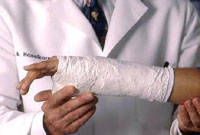Treatments >
Non-Surgical Options
Treatments
>
Surgical Options
Treatment of Fractures
When you break a bone, the most common treatment is
to realign or restore the broken bone to its original position.
Usually, this is done by manipulating the bones manually and an
operation is not needed. However, once you break a bone, some
distortion or displacement will invariably result. It is very
difficult to realign broken bones exactly as they were before
they were injured. However, the human body is wonderfully designed and
very adaptable. We have some latitude when realigning and resetting a
bone which, after healing, will enable the bone to adequately perform
all of its normal functions. The realignment may not be perfect, but
it is certainly adequate for us to resume our regularly-scheduled
lives.
There is a great deal of reserve in the human wrist
joint. Most people are able to flex and extend their wrist through an
incredibly wide arc of 160 to 180 degrees. They can extend it 90
degrees, and they can flex or bend it down to 90 degrees; however, it
is only necessary to have about 20 degrees active flexion and 20
degrees active extension, for a total arc of about 40 degrees. So even
this limited amount of mobility still allows one to use his hand and
wrist in most of its normal functions. Remember, as long as the wrist
is pain-free, its function is not significantly impaired.
Radius and ulna fractures are the most common fractures. Treatment
usually consists of using a cast to hold the position of the bones for
6-8 weeks.
Scaphoid Fractures
Scaphoid fractures present a special problem because they are
difficult to diagnose initially, and the poor blood supply hampers
healing. It may be necessary to place the injured wrist inside a cast
for an extended period of time, up to 3 months, in order to allow the
fracture to heal. If the wrist does not heal, then
surgical treatment is necessary.
Carpal Tunnel Syndrome
The initial treatment of
Carpal Tunnel Syndrome usually involves immobilizing the wrist and
hand with a splint (see illustration at left), and modifying
the pattern of activity. A splint can be very useful, especially at
night. It allows the wrist to be maintained in a position of
extension, and this helps relieve the pressure on the painful area.
Other potential non-surgical treatments for wrist
pain include steroid injections. With Carpal Tunnel Syndrome,
steroid injections into the carpal canal are not recommended, because
of the potential for permanent nerve damage.
DeQuervain’s Disease
With
DeQuervain’s Disease, the first approach to treatment is to modify
the activity which is causing the problem, by changing the pattern in
which the hand and wrist are used. In some cases, it may be necessary
to restrict the activity that is causing the problem. The wrist can be
rested by immobilizing it in a splint (see illustration at left),
which allows the swelling and inflammation to subside. Medication can
also be used to alleviate the swelling, reduce the inflammation, and
relieve the pain.
DeQuervain’s Disease is frequently treated with the
injection of steroid medication and local anesthesia such as Lidocaine.
This treatment is often very effective, and in some cases has
completely resolved the problem.
Treatments for Arthritis
Initially, over-the-counter medications such as
aspirin, ibuprofen, and acetaminophen are used. If these medications
prove to be unsuccessful, there are a number of anti-inflammatory,
analgesic medicines that can be prescribed by a doctor.
